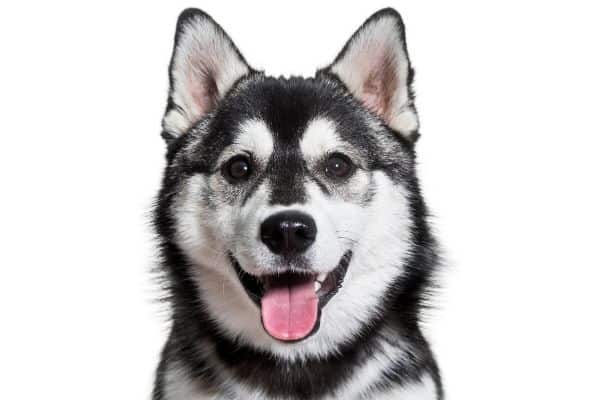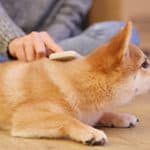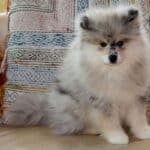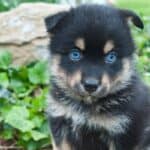When the friendly, dignified Siberian Husky is paired with one of the most popular toy breeds, the perky Pomeranian, the result is the energetic, affectionate Pomsky. A relatively new crossbreed, Pomskies resemble their Siberian Husky mothers in appearance but will only grow to be between 20 – 30 pounds thanks to their Pomeranian fathers.
While many people are familiar with the Siberian Husky’s sled dog history, many are surprised to learn that the tiny, regal Pomeranian can also trace his roots back to sled dogs of cold, northern climates. It’s no wonder that both these breeds have lots of fur and a thick undercoat, and of course, their offspring, Pomskies, are quite well furred too.
Do Pomskies shed? Yes. Pomskies are medium to heavy shedding dogs. Unless they live in frigid climates, Pomskies will typically shed throughout the year and undergo two seasonal sheds per year.
These times of heavier than normal shedding is known as ‘blowing their coat’. One usually occurs in Spring and the other (lighter one) in the Fall.
If you’re considering getting one of these adorable designer dogs for yourself, it’s helpful to know exactly what to expect as far as shedding goes and some useful tips for dealing with both seasonal and everyday shedding.
So, keep reading before you go out and purchase a heavy-duty vacuum cleaner and an expensive array of grooming paraphernalia.
How Much Does a Pomsky Shed?
We won’t try to sugarcoat this. Pomskies do shed, but to be fair, so do all dogs. While they aren’t the heaviest shedders known to man, there will be a good amount of flying fur to deal with.
Because both of the parent breeds sport a lush, double coat, Pomskies are genetically predisposed to shedding. Let’s take a quick look at the two types of shedding that Pomsky owners can expect.
Everyday Shedding
Daily shedding is a normal process as the dog’s body eliminates older, damaged hair and replaces it with new growth. For dogs living in very cold climates, the amount of daily hair loss will be quite minimal. For the majority of Pomskies, this isn’t the case.
Because most Pomskies live indoors with their families and will experience changing outdoor temperatures as the seasons rotate in their cycle, moderate daily shedding is quite normal for this mixed breed.
Should you rip out all of your carpeting and cover your furniture with plastic? No. The daily shedding isn’t nearly that intense.
Will you see some hair throughout the house and find some clinging to your clothes and upholstery? Yes.
Seasonal Shedding
On the other hand, seasonal sheds will be much more intense. In the Spring, Pomskies will completely “blow their coat” as their body prepares for the coming warmer temperatures.
Nearly all of the undercoat will be shed and replaced by a much lighter, less dense version.
In the Fall, Pomskies will again go through a seasonal shed as the summer undercoat makes way for the warm winter coat.
Both of these seasonal sheds are totally normal and are a sign that your Pomsky’s body is functioning normally.
While the process of blowing their coat, which can last up to several weeks, is occurring, you can expect to see much more hair scattered throughout your home. By the time the process is finished, the amount of shed, fluffy hair is often enough to fill a trash bag.
A bit of a hassle? Yes.
Normal? Yes.
What Impacts the Amount a Pomsky Will Shed?
Seasons
The changing temperatures and the shorter/longer days that come as one season transitions into the next trigger a dog’s body to respond according. Ah, the wonders of nature.
Health and Nutrition
Generally, healthy, properly fed dogs don’t shed quite as much as those suffering physically. Conditions such as illness, malnutrition, injury, and parasites deplete the dog’s body of stored resources and can cause overall weakness which in turn results in an unhealthy coat that sheds more than normal.
Stress
Major changes to a dog’s life such as moving into a new home or having a favorite family member head off to college can cause significant stress and changes in the amount of shedding. Whelping and nursing a litter also stress the body and often trigger a major shed.
Genetics
Because Pomeranians aren’t quite as extreme as Siberian Huskies are in the shedding department, Pomskies with a heavier concentration of Pomeranian in their bloodline may shed slightly less than those with lots of Husky in their background.
Consistent Grooming Practices
Matting of the undercoat can occur when routine brushing is neglected and lead to various problems such as skin infections and discomfort. If left unchecked, these problems can snowball into more serious issues, one of which is significant hair loss.
Managing Pomsky Shedding
Other than vacuuming more than usual, there are some additional steps you can take to prevent that luxurious fur from taking over your home.
Routine Brushing
Brushing out dead hair from the coat is the best way to stay on top of all that fur. Just follow these simple steps:
- Take your Pomsky for a long walk to use up some of that energy before you begin.
- Do a quick exam to check for any cuts, sore areas, fleas, or hotspots.
- Go over the entire coat with a slicker brush to remove any dead hair on the surface and to check for any mats.
- Use either a deshedding tool like the Furminator or an undercoat rake to work through the undercoat.
- Finish up by using the slicker brush again and reward his good behavior with a special treat and a snuggle.
Tip: Many Pomsky owners use a deshedding shampoo (like this) during seasonal sheds to deeply clean the undercoat and make it easier to remove when brushing.
Supplements
In addition to a well-balanced diet, you may want to consider adding a nutritional supplement (like these) designed to help with shedding. They are typically high in flaxseed, vitamin E, and omega fatty acids to nourish both the skin and coat.
How Much Grooming Does a Pomsky Need?
Under ordinary circumstances, Pomsky owners can usually get by with a thorough brushing, being certain to reach the undercoat, once per week, though once every few days is ideal. This routine will ensure that mats don’t have a chance to form and that the natural skin oils are evenly distributed throughout the coat to keep it supple, shiny, and healthy.
During times of seasonal shedding, you’ll want to increase your efforts quite a bit. Brushing once or twice per day is recommended. I know that seems like a lot of work, but it will help to remove most of the loose hairs before they drift into unsightly piles in the corners of your house.
Tip: Weather permitting, brush your Pomsky outside.
If you find yourself falling behind on the grooming routine or discover that mats have formed close to the skin, a trip to the groomer’s might be called for. The cost typically runs between $30 – $65 and includes a bath, blow-dry, brushing, nail trimming, and ear cleaning.
Tip: Be sure to notify the groomer that your Pomsky is not to be clipped other than to remove any mats. Trimming their coat is never recommended and can lead to severe skin and coat problems.
What Actual Pomsky Owners Say About Shedding
“At first, we were hopeful that we hit the jackpot with a non-shedding Pomsky but, when he got to be around 6 months old, that changed. We always keep a handheld dirtdevil nearby to keep up with all of the hair.”
“Gotta get get in the brush all the time habit to try to mitigate the loose hairs as much as possible where you want them. You’ll still get hair everywhere but hopefully not AS much.
“It’s constant-and worse during the end of summer. I bought a robot vacuum to deal with it, and it is a HUGE help. The pomsky likes to chase it, so there’s that too…lots of pomsky exercise!”





